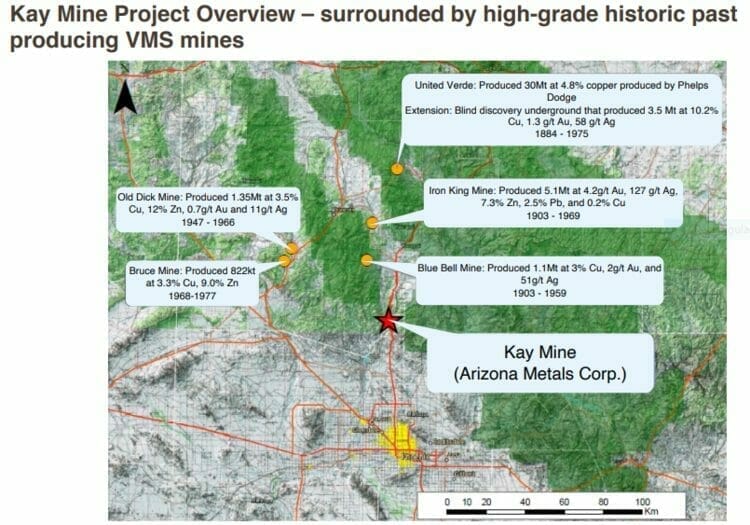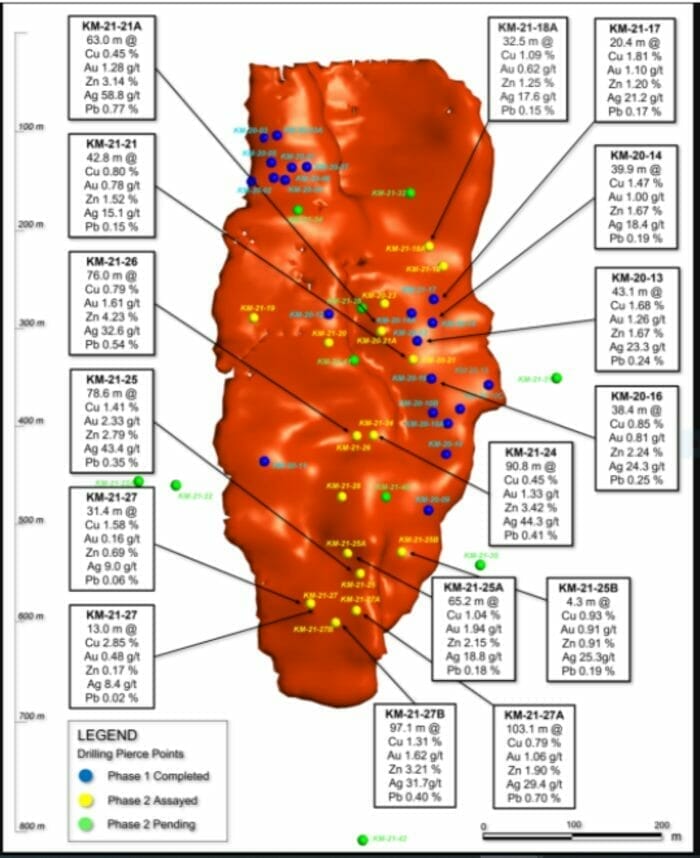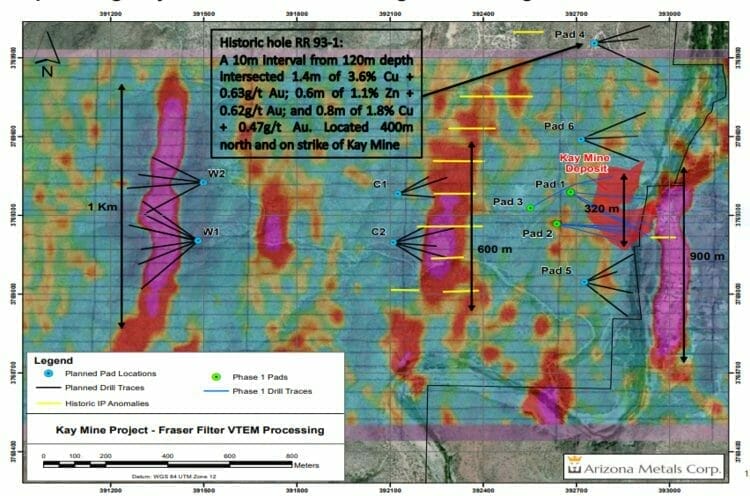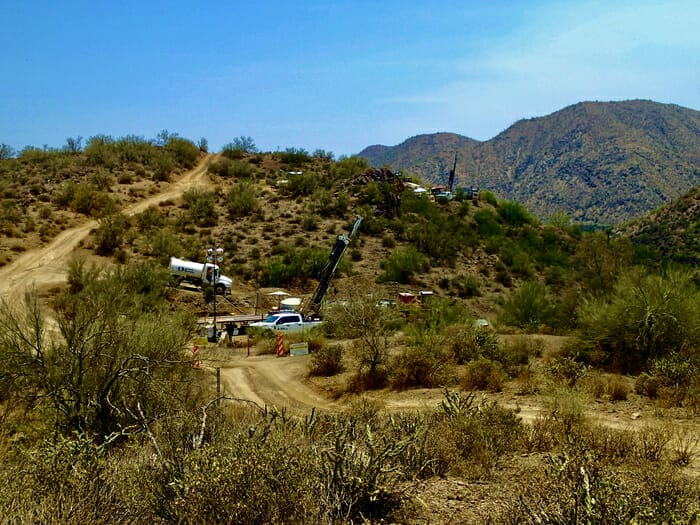On July 26th, Arizona Metals (AMC.V) released another round of outstanding drill hole results from its flagship Kay Mine Project in mining-friendly Arizona. Scroll down the page if you’re pressed for time. Otherwise… indulge me for this bit of context.
This flagship project is located in a prolific mining district in Arizona, a world-class jurisdiction currently ranked #2 by the esteemed Fraser Institute (Arizona is the leading producer of copper in the U.S.).

This district has had a century-long run. No less than 60 past-producing underground Cu-Au-Zn mines, good for ~4 billion pounds of copper, operated within a 150-kilometer radius of Kay.
We’re looking at a Volcanic Massive Sulphide (VMS) district here. Spawned by volcanic hydrothermal events in submarine environments, VMS deposits rarely occur in isolation. They almost always occur in clusters—where there’s one deposit (or lens)… there are often others.
The granddaddy of this district was United Verde—30Mt at 5% copper plus an extension deposit that produced 3.5 Mt at 10.2% Cu, 1.3 g/t Au, and 58 g/t Ag.
The Kay Mine Project carries a (historic) resource. In the early 1980s, Exxon Minerals reported a “proven and probable reserve of 6.4 million short tons grading 2.2% copper, 2.8 g/t gold, 3.03% zinc, and 55 g/t silver.” ***
The Company is currently in the midst of an aggressive 75,000-meter Phase-2 drill campaign at Kay. The program was recently accelerated with the addition of a third drill rig.
The new discovery
First announced on May 19th, a new gold-rich zone of open-ended mineralization came into play highlighted by Hole 25 which intersected 79 meters of 2.33 g/t Au, 1.41% Cu, 2.79% Zn, and 43.4 g/t Ag (or 7.0 g/t AuEq), including two separate higher-grade intervals of 9 meters grading 18.1 g/t AuEq and 11 meters grading 14.7 g/t AuEq (from a vertical depth of 638 meters).
This new discovery is located in an area between the zones that carry the historic resource (the North and South Zones)—an area that was overlooked by previous operators. This new zone remains open for expansion at depths below 450 meters.
On June 30th, these new discovery holes were bolstered by a highlight hit in Hole 26 which intersected 76 meters grading 1.6 g/t Au, 4.2% Zn, 0.8% Cu, and 33 g/t Ag, including two separate higher-grade intervals of 14.9 meters grading 1.8 g/t Au, 9.7% Zn, 0.7% Cu and 43 g/t Ag, and 9.0 meters at 6.1 g/t Au, 4.0% Cu, 3.3% Zn, and 18 g/t Ag (from a vertical depth of 475 meters). Again, broad intervals of mineralization ranging from 63 meters to 76 meters, with true widths estimated at an average of 80%.
Commenting on these extraordinary results, Mark Pais, CEO:
“The first few holes drilled in the discovery zone were on a large step-out spacing of 100 m to 150 m. Subsequent branch holes to infill between these holes are demonstrating excellent vertical continuity, as well as lateral extension of mineralization on strike to both the north and south.”
Connecting the dots—establishing good (vertical) continuity—is the key to establishing positive economics in any underground mining scenario.
The July 26th headline…
Here, the Company announced results from four additional holes—broad intervals of high-grade mineralization that extend deeper—at least 100 meters deeper—than reported by previous operators.
Highlights:
- Branch Hole 27B intersected 97 meters at a grade of 1.3% Cu, 1.6 g/t Au, 3.2% Zn, and 32 g/t Ag, including higher-grade intervals of 15 meters grading 5.0% Cu, 0.4 g/t Au, 0.4% Zn, and 19 g/t Ag, as well as 21 meters grading 4.6 g/t Au, 9.0% Zn, 0.9% Cu, and 82 g/t Ag. This hole is the deepest drilled to date by Arizona Metals Corp, and extends the new gold-zinc discovery zone by 20%, to a depth of 750 meters.
- Branch Hole 27A intersected 103 meters at a grade of 0.8% Cu, 1.1 g/t Au, 1.9% Zn, and 36 g/t Ag, including higher grade intervals of 21 meters grading 3.2% Cu, 1.4 g/t Au, 1.3% Zn, and 19 g/t Ag, as well as 18 meters grading 0.7% Cu, 2.7 g/t Au, 4.7% Zn, and 92 g/t Ag.
- Hole 28, which was drilled to test for vertical continuity of high-grade zones between holes 25 and 24, intersected 54 meters at a grade of 1.9% Cu, 2.9 g/t Au, 5.0% Zn, and 29 g/t Ag, from a vertical depth of 585 meters below surface. Hole 28 includes three separate higher-grade intervals of 11.4 meters grading 4.3 g/t Au, 9.3% Zn, 0.5% Cu, and 32 g/t Ag, as well as 7.9 meters grading 4.4% Cu, 9.5 g/t Au, 10.3% Zn, and 93 g/t Ag, and also 2.2 meters grading 16.1% Cu, 0.8 g/t Au, and 56 g/t Ag.
- Hole 27 was drilled as a trunk hole at the northern edge of the new discovery zone and intersected 31.4 meters grading 1.6% Cu, 0.2 g/t Au, 0.7% Zn and 9.0 g/t Ag, and 26 m meters further downhole, intersected 13 meters grading 2.9% Cu, 0.5 g/t Au, 0.2% Zn, and 8.4 g/t Ag.
The map below is a section view looking north.

Without a doubt, these wide, newly defined high-grade intervals carry the potential to add significant tonnage outside of the historic resource block.
“The four drill holes released today validate and extend the new gold-rich zinc zone discovery, with broad intervals of mineralization in the discovery zone ranging from 54 m to 103 m, and true widths estimated at an average of 80%. Hole 27 demonstrates that mineralization extends at least 100 m deeper than reported by previous operators. Holes 27A and 27B have encountered excellent grades and thicknesses, as good or better than those reported in the discovery holes, while also demonstrating the potential for the discovery zone to both extend at depth and increase on strike as it deepens. The first few holes drilled in the discovery zone were on a large step-out spacing of 100 m to 150 m. Subsequent branch holes to infill between these holes are demonstrating excellent vertical continuity, as well as lateral extension of mineralization on strike to both the north and south. Of particular note is hole 28 (located at the vertical mid-point of holes 24 and 25), which intersected 54m of mineralization, including significant intervals of higher grade within. This hole is the widest zone of high-grade drilled at the project to date, and demonstrates excellent continuity of both grade and thickness with the holes above and below. Today’s results have increased the vertical extent of the discovery zone (now defined from hole 21A to 27) to approximately 400 m. Drill holes are currently underway to test for further extensions by testing 200 m above hole 21A and also 200 m below hole 27. With the recently completed financing of $21 million, the Company is fully-funded to complete the 75,000 metre Phase 2 expansion program.”

The above map is a long section displaying the Phase 2 drill holes.
Final thoughts
There’s every indication that Arizona Metals is on to a world-class VMS deposit.
It’s hard to overstate the significance of this new gold-rich zone and its potential to grow a significant resource base.
There are other high-priority drill targets on the property. The Central and Western targets (C1 and C2 – W1 and W2 on the map below) represent a compelling speculative facet—an element of intrigue if you will—to this rapidly evolving (VMS) story. Both will receive a proper probe with the drill bit during this Phase-2 campaign. Note the scale on the map—the Western targets are a full one kilometer from Kay’s historic resource.

The narrative now becomes, how big can this thing get? Or, more precisely… could this turn into another United Verde? If the Company continues to encounter broad intervals of high-grade mineralization outside the historic resource block, the answer is an emphatic “YES”.
END
—Greg Nolan
Full disclosure: Arizona Metals is an Equity Guru marketing client.
*** The historic estimate has not been verified as a current mineral resource. None of the key assumptions, parameters, and methods used to prepare the historic estimate were reported, and no resource categories were used. Significant data compilation, re-drilling and data verification may be required by a “qualified person” (as defined in National Instrument 43-101 – Standards of Disclosure for Mineral Projects) before the historic estimate can be verified and upgraded to be a current mineral resource. A qualified person has not done sufficient work to classify it as a current mineral resource, and Arizona Metals is not treating the historic estimate as a current mineral resource.

